
Manufacturing

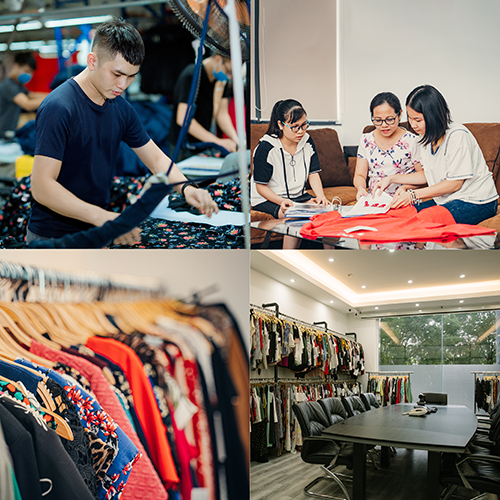
Capital World Group Provides Full-package women’s apparel manufacturer in Vietnam
Translating a fashion concept into a tangible garment requires more than sewing and stitching. It is about turning a creative vision into a market-ready product through the right mix of expertise, technology, and commitment. Capital World Group offers a full-package women’s clothes manufacturer model from fabric preparation and sourcing to design development, clothes production, packaging, and shipping.
With over 40 years of experience in the garment industry, our company is supported by skilled professionals and advanced machinery. We combine craftsmanship with modern efficiency, ensuring each piece meets the design specifications, timeline, and quality standards of global fashion brands.
Services that Capital World Group provides
Capital World Group offers an end-to-end full package garment manufacturing process that covers the complete production cycle. Each process is managed within our facility, ensuring full visibility, smooth coordination, and consistent quality. This structure enhances efficiency and keeps production aligned with brand timelines and quality expectations.
Fabric sourcing and development
Fabric sourcing is planned according to your design brief, cost target, and production schedule. We work with a network of mills providing competitive options for both standard and specialty textiles. Co-development is available for customized fabrics, including adjustments in GSM, drape, finish, and blend, supported by lab dips and strike-offs. With in-house sampling and dedicated capacity, we ensure that each fabric meets your design and performance goals with a thoughtful fit and grading strategy.
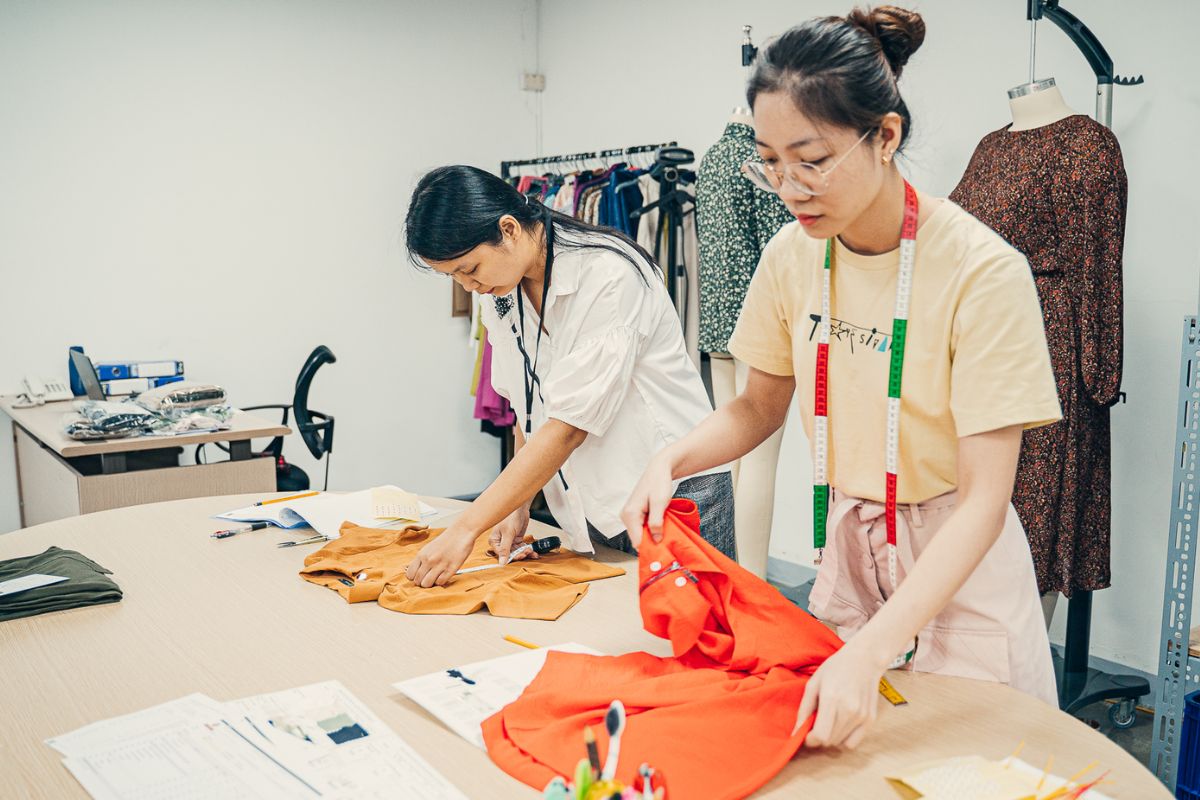
OEM/ODM Manufacturing
Following the women’s apprel product requirements, our OEM and ODM manufacturing services allow brands to focus on design direction, marketing, and distribution. This structure supports creative freedom while keeping production costs optimized and lead times shorter for large-scale operations.
Production
- Trim & accessory sourcing
- Pattern making & grading
- Sample development
- Sewing & bulk production
Packing and shipping assistance
Many fashion brands face shipping delays and higher costs when production stages are divided among different suppliers. The Capital World Group fibre to fashion full package service keeps every process in one managed system. Each stage, including fabric preparation, cutting, stitching, finishing, and packing (strictly follow the packaging requirements), is controlled with strict in-line quality checks. Our logistics team coordinates export activities efficiently through Hai Phong Port (HPH) or Hanoi Airport (HAN), ensuring smooth and timely international delivery.
Capital World Group – Your trusted full package clothing manufacturer
Capital World Group specialises in being a ladies’ clothing manufacturer producing competitive, quality women’s wear. Our experienced team provides quality garments supported by efficient production and professional presentation. The full package service model guarantees accuracy, consistency, and timely results at every stage with:
- Minimum order quantity (MOQ): 3000 pcs per style
- Average sample turnaround: 10 days
- Sampling capacity: 500 pcs per week
- Fabric origin: China, Taiwan, South Korea, Vietnam, India
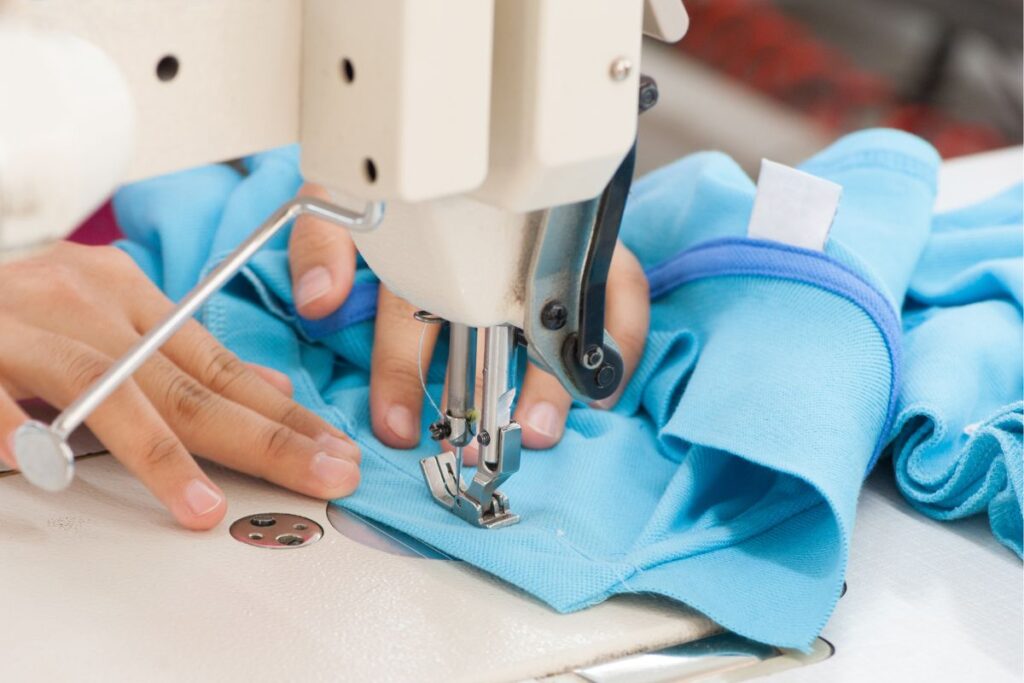
Finishing details: linings, interfacings, hems for womenswear
Textile finishing represents the final stage of the manufacturing process, transforming raw fabric into a product ready for wear. Each finishing technique contributes to comfort, aesthetics, and durability. Without these refinements, most textiles would remain coarse, weak, or easily damaged. Finishing enhances softness, improves drape and flow, strengthens fibers, and refines texture for a skin friendly feel. Properly executed finishing ensures every garment combines longevity, elegance, and comfort, which are essential in types of finishing detail for womenswear
Lining fabric method
The lining serves as the inner layer of garments, distinct in both function and material. It enhances comfort while protecting the outer fabric and preserving shape. Typically smoother and softer than the exterior, it allows the garment to move gracefully with the body. A well-chosen lining elevates the textile finish and complements the drape of the design.
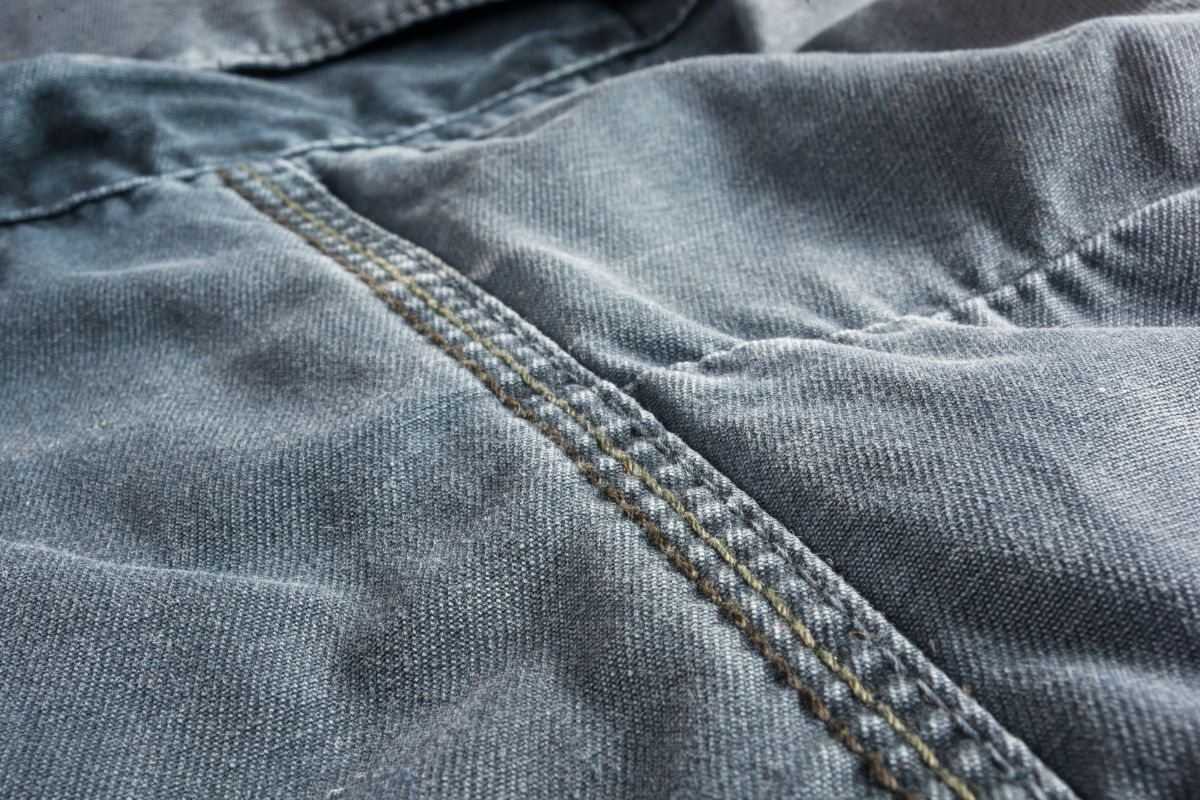
Purpose:
- Provide a smooth interior finish.
- Conceal inner construction such as seams and interfacings.
- Improve garment drape and overall comfort.
Tips:
- Allow ease in the lining for natural movement.
- Attach at critical seams including neckline, armholes, and waistline.
- Hem the lining slightly shorter to maintain a clean, professional edge.
Interfacing finishing method
Interfacing is an essential internal component applied beneath the garment fabric to add structure or shape. It plays a key role in ensuring stability in design areas exposed to strain or repetitive motion. Commonly used in collars, cuffs, clothing edges, waistbands, and plackets, interfacing supports both form and function while retaining garment fluidity and drape.
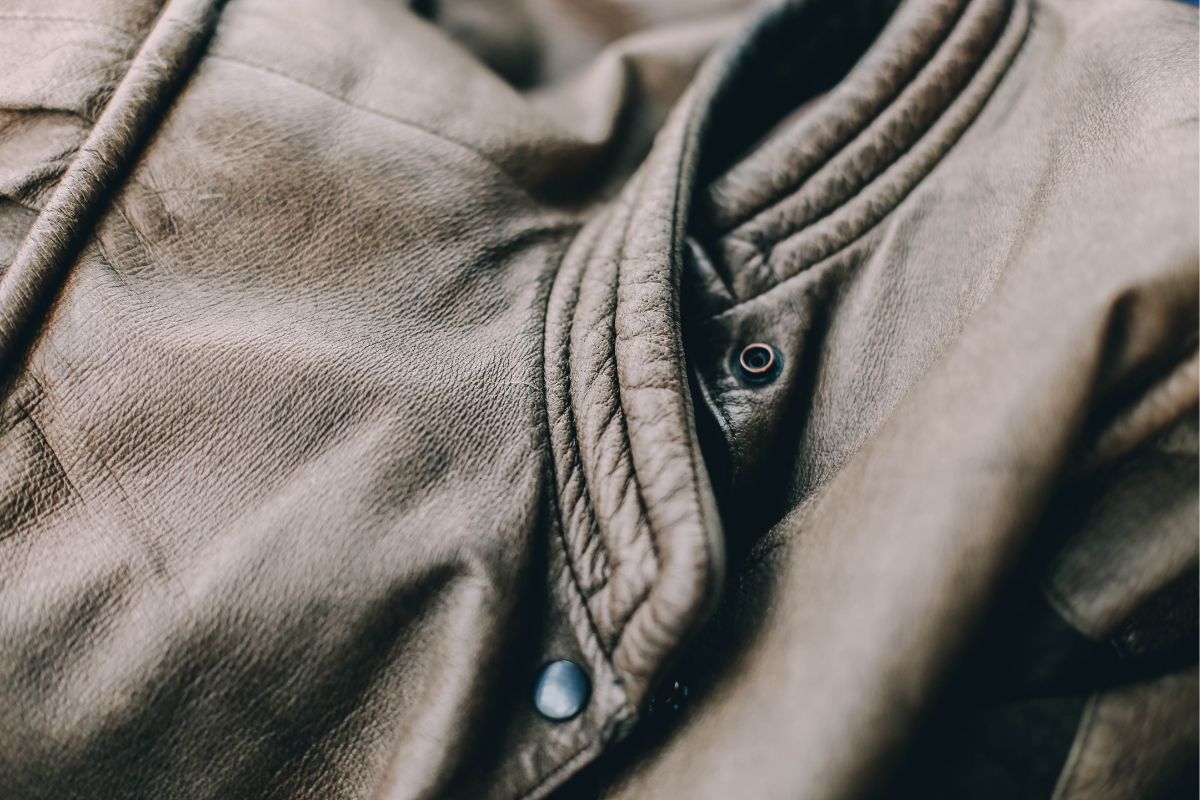
Purpose:
- Provide structure and stability to key sections.
- Prevent stretching or distortion.
- Reinforce closures in high use zones.
Tips:
- Match interfacing weight to the main fabric for balanced performance.
- Test adhesion and texture on fabric scraps before application.
- Choose lightweight fusible interfacings for delicate textiles to maintain softness and flow.
Hems finishing method
A hem represents the final touch in garment construction. This finishing step involves folding and stitching the clothing edges to secure the fabric, control length, and prevent fraying. Beyond utility, hems influence the garment’s drape, balance, and overall appearance. The choice of hemming technique depends on textile weight, texture, and intended drape.

Purpose:
- Secure raw edges and prevent unraveling.
- Define garment length while adding weight control.
- Deliver a refined, durable finish with clean lines.
Tips:
- Press hems carefully before stitching for accuracy.
- Select suitable thread and stitch settings for each textile finish.
- Hang garments before hemming to ensure natural alignment and even edges.
Kiara Garments of Capital World Group – Your trusted clothing manufacturer in Vietnam
Capital World Group specialises in being a women’s clothing manufacturer producing competitive, quality women’s wear. Our factory, Kiara Garments, focuses on excellence in detail through advanced finishing techniques and quality craftsmanship. Expert teams emphasize lining, interfacing, and hems to achieve superior texture, softness, and drape, which are the essential garment product requirements to maintain quality. Each production step is engineered for consistency, comfort, and style, ensuring premium results across diverse apparel categories.

Fit and grading strategies for women’s apparel collections
Accurate fit and grading strategy ensures each garment matches its target wearer while supporting scalable production. For women’s clothing manufacturers, precise body measurement, pattern grading, and proportional grading define comfort, brand image, and consumer trust. Strategic body fit analysis and data-driven scaling also enhance consistency across collections, reducing costly returns and improving brand reputation.
Fit strategy for women’s apparel collections
A fit strategy defines how garments will fit the target customer, balancing aesthetics, comfort, and brand identity. This helps the factories to meet garment products’ reuqirements before handling packages to businesses.
Factors to consider for perfect fit strategies
- Demographic data collection: Lifestyle and socio-economic data inform sizing patterns; yet, few brands leverage such insights effectively.
- Fitting perception: Each stakeholder perceives fit differently—designers, pattern makers, and end users often diverge in expectations.
- Design and style: Fabric type and silhouette dictate appropriate fit type adjustments and garment balance.
- Size labels: Clear labeling aligns consumer expectations with real body measurement outcomes.
- Sizing criteria: Brands determine fit standards pre-production, based on size standard and regional data.
- Plus-size garments: Plus-size fitting demands adjusted proportions, not simple enlargements.
- Fit test: Repeated tests validate comfort, shape retention, and aesthetic alignment for fit points approval before your bulk ordering.
Fit development process
- Measurement standards: Develop charts from anthropometric or retail benchmarks (ASTM, ISO, or proprietary scans).
- Sample size selection: Use the midpoint of the range for accurate proportioning.
- Prototype fitting: Test on fit models who represent true body shapes.
- Fit corrections: Adjust patterns for proportion and silhouette accuracy.
- Consistency checks: Maintain a “fit library” to preserve cross-season uniformity.
Grading strategy for accurate sizing
Pattern grading converts a base size into multiple sizes, maintaining the same shape and proportions through proportional grading. There are three popular methods for grading:
- Cut and spread method: Involves slicing the pattern and spreading or overlapping to achieve scaling precision.
- Pattern shifting method: Moves the pattern by equal distances to redraw the shape, ensuring accuracy.
- Computer grading: Digitized grading via advanced software increases speed and precision.
A grading rule determines how each point of measurement changes to accommodate varied sizes. Effective grading ensures proportional balance across size standards and categories like jackets, tops, or dresses.
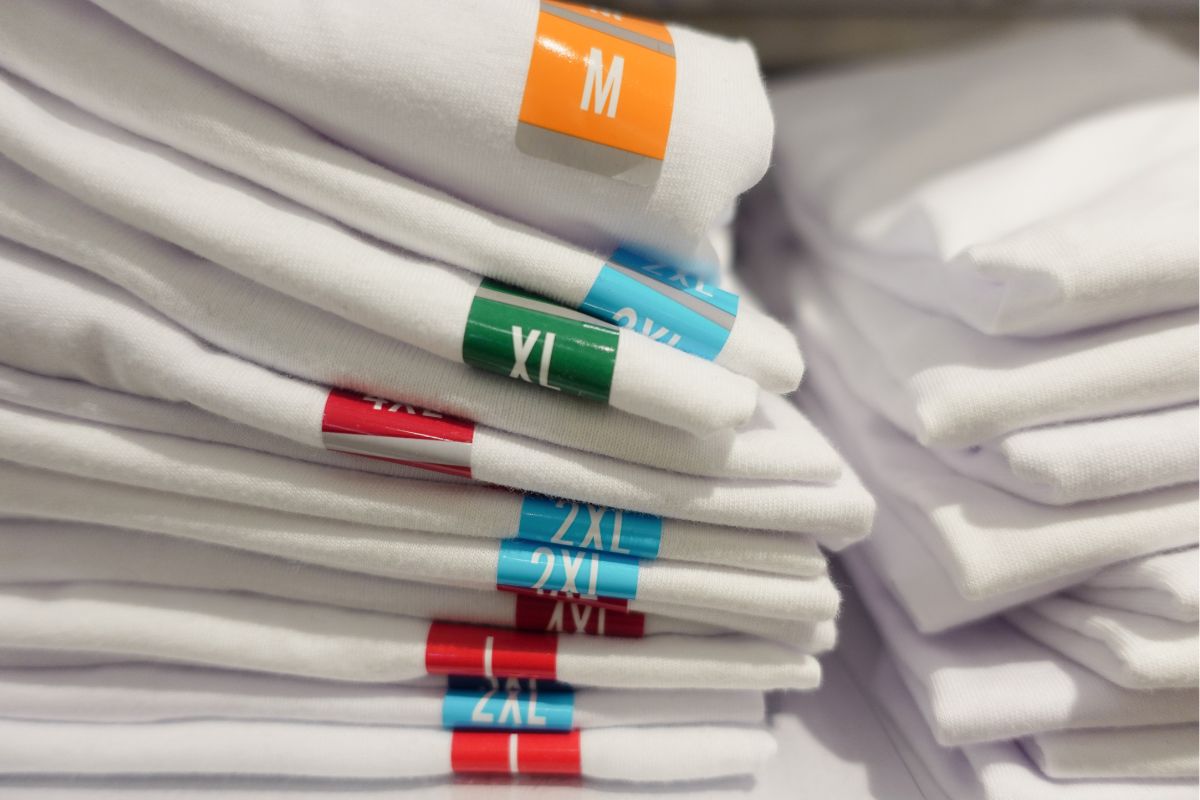
Get the best quality clothing with Capital World Group
Capital World Group specialises in being a ladies’ clothing manufacturer producing competitive, quality women’s wear and garments. Each garment reflects meticulous body measurement alignment, consistent size standards, and exceptional craftsmanship.
As part of Capital World Group, Kiara Garments ensures every collection achieves international quality levels, combining aesthetic appeal with comfort and scalability. With a full-package service in women apparel manufacturing, the brand focuses on producing stylish, well-fitted women’s wear that enhances brand reputation, boosts customer satisfaction, and strengthens competitiveness in today’s global fashion market.
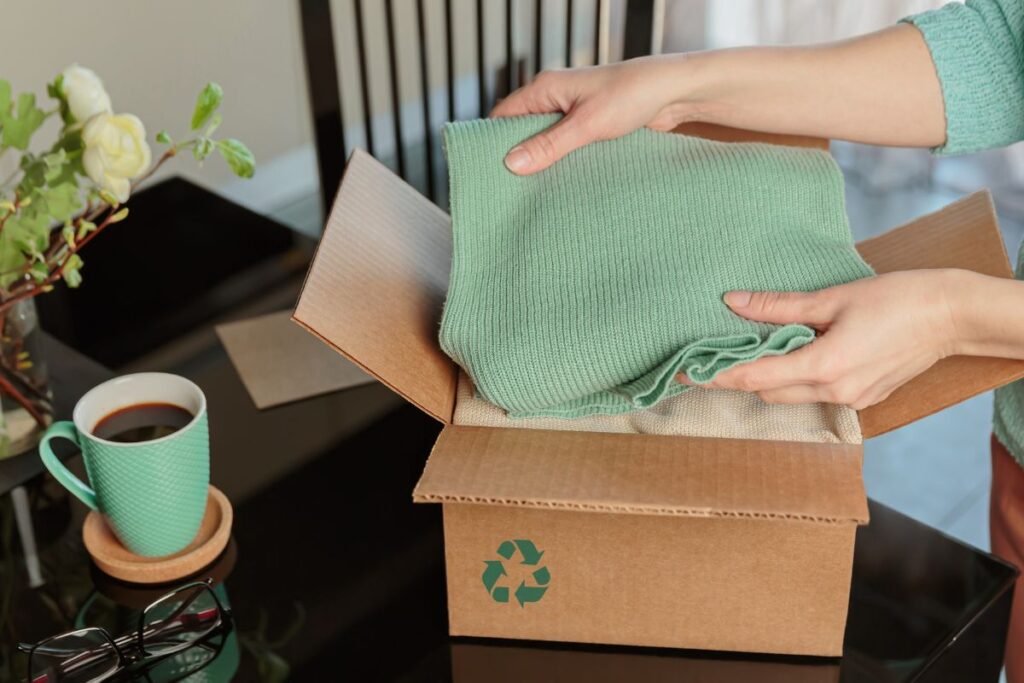
Packaging presentation requirements for women’s clothing brands
In women’s fashion, packaging plays a vital role in shaping how a brand is perceived. It is not only about wrapping garments but also about telling a story of quality, creativity, and care. The right packaging presentation requirement ensures protection during transit, enhances the product’s visual appeal, and strengthens brand identity. More than ever, brands must balance functionality with sustainability, using packaging as an extension of their design philosophy and values.
Branding
- Reflect the brand tone: The packaging should clearly represent your brand’s style and values, from minimalist elegance to bold sophistication.
- Focus on the unboxing experience: The unboxing experience shapes a customer’s emotional connection with your brand. Consider how your box, tissue wrap, and accessories such as ribbons or stickers make opening the package memorable.
- Support visual identity: Maintain consistent use of logos, colors, and materials across all packaging elements including shipping boxes, retail bags, and garment bags.
- Premium finishes for retail or gifting: For retail display or gifting, invest in quality details like rigid boxes, specialty papers, or embossing to elevate the brand’s perceived value.
Functional and logistics
- Protection: Packaging must secure the product throughout export and import processes, shielding garments from moisture, dust, or compression.
- Structure and folding: Proper folding, alignment, and packaging ensure garments arrive in perfect condition and are presentation-ready.
- Supply chain readiness: Ensure packaging supports handling efficiency in storage, shipment, and retail display.
Material and sustainability
- Reusable or recyclable materials: Select materials that support reuse or recycling without compromising durability.
- Brand alignment: Choose materials that reflect brand values, whether eco-friendly kraft paper or FSC-certified cardboard.
- Avoid over-packaging: While layered packaging can feel luxurious, excessive wrapping increases waste and cost.
- Compliance: Stay informed about retailer and regional regulations for packaging materials, especially in export markets.
Labeling and information
Packaging and labels must display accurate brand details, size and fit, fiber content, country of origin, and care instructions. Use clear tags, stickers, or inserts such as thank-you and care cards to communicate essential information and reinforce branding.
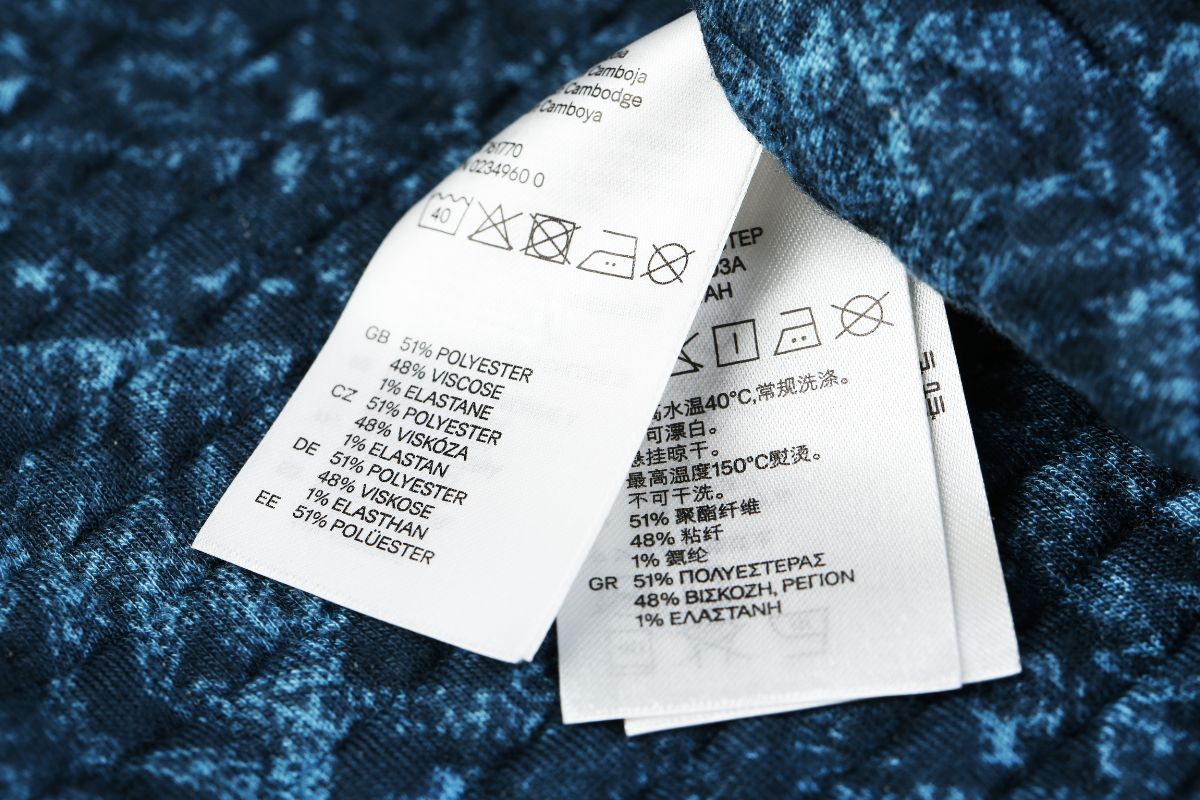
Quick checklist for packaging requirements
| Criterias | Check |
| Outer shipping/transport carton: size, material, transport labels | |
| Retail or consumer-facing packaging: box, bag, dust bag | |
| Inner protective packaging: tissue paper, polybag, wrap | |
| Brand identity: logo placement, colors, finishes (foil, emboss, matte) | |
| Labeling: size, content, care instructions, origin | |
| Folding or hanging instructions for manufacturers | |
| Sustainability: recycled content, recyclability, reusability | |
| Logistics: weight, size, protection, efficiency | |
| Unboxing experience: thank-you card, branded stickers, custom tape |
Kiara Garments – Your trusted clothing manufacturer factory
Capital World Group specialises in being a ladies’ clothing manufacturer producing competitive, high-quality women’s wear for global brands. At our factory, Kiara Garments, we understand that packaging is an essential part of a brand’s identity. Our expert teams create women’s clothing that not only meets high production standards but also aligns with your packaging presentation requirements. From sustainable materials to customized branding elements, every detail reflects your brand’s image.
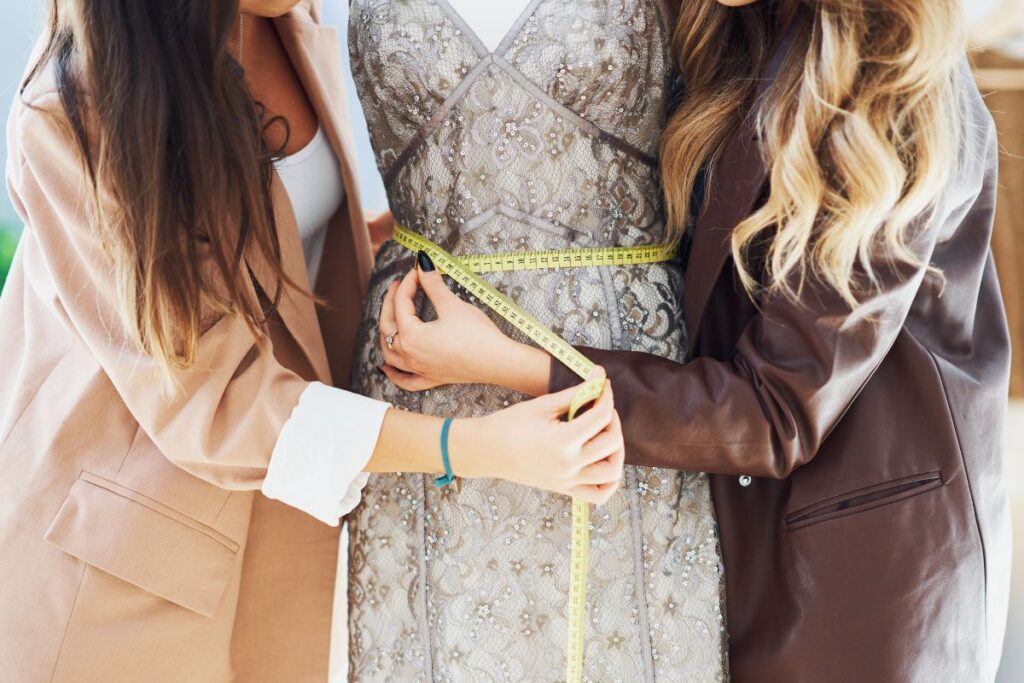
Checklist: 20 fit points you must approve before bulk ordering
In garment manufacturing, precision in fit determines how well a style performs once it reaches the customer. Before confirming bulk orders, brands must evaluate specific fit points to ensure each sample aligns with design intent and body proportions. A single misjudgment can lead to costly returns, markdowns, and even production stoppages. By approving each fit point carefully, brands maintain consistency in their ready-to-wear clothes, minimize waste, and protect their reputation in competitive apparel markets.
Why is fit approval important for bulk orders?
Fit defines the customer experience. For many buyers, especially women and teenagers, the decision to purchase a readymade garment depends on how it looks and feels when worn. Fit is not just about comfort or coverage but also about confidence and appearance. A garment that pulls, twists, or loses shape quickly becomes unsellable.
Inaccurate measurement or incomplete fit approval can waste materials, time, and resources. Once bulk production begins, small deviations multiply into larger financial losses. Approving the correct fit before manufacturing ensures every style delivers the intended comfort, proportion, and brand identity.

Checklist for fit points approval
Use well-prepared clothing samples to conduct your fit review. Confirm these fit points, which are essential parts in the garment manufacturing process, to approve before bulk orders:
| Fit points | What to check |
| Base size specification & tolerances | Confirm that all key measurements match the approved spec sheet and stay within agreed tolerances. |
| Size set coverage | Evaluate the base size plus one size above and below to verify proportional grading accuracy |
| Overall balance & symmetry | The garment should hang evenly, with straight side seams, level hems, and consistent left–right balance. |
| Length verification (CF, CB, Outseam, Inseam) | Measure all length points and ensure they provide the intended body coverage. |
| Chest, bust, or hip sweep | Check for strain lines or pooling that indicate tightness or looseness at key body points |
| Shoulder width & slope (tops) | Shoulder points must align with the body’s natural edge. Incorrect slopes create drag lines at the neckline or sleeve |
| Armhole depth & mobility | Movement should feel natural. Avoid gaping under the arm or tension across the back. |
| Sleeve length & pitch | Sleeves should reach the correct point when relaxed and maintain shape when flexed |
| Bicep or thigh circumference | Ensure movement comfort without visible tightness or distortion. |
| Neckline & collar fit | Collars should lie flat and centered. Watch for gaping, choking, or rolling edges. |
| Waist, rise & crotch depth | Confirm that the waistline remains level and comfortable through movement. Check rise fit while sitting and standing |
| Seat & hip shape | The seat should appear smooth with clean pocket placement. Uneven drag lines signal imbalance |
| Hem opening & sweep control | Confirm that hems suit the intended footwear and allow natural walking motion |
| Closure function | Zip, button, and snap repeatedly to ensure smooth operation under tension |
| Pocket position & usability | Verify access, depth, and shape retention during wear. |
| Stretch & recovery | Test stretch fabrics to their target percentage and observe recovery speed and shape retention |
| Shrinkage appearance | Wash and dry the garment, then re-measure. Check for twisting, puckering, or uneven shrinkage. |
| Construction quality | Review seams, stitches, and reinforcements at stress points such as pockets and zippers. |
| Labels, trims & compliance | Confirm correct label placement, legal requirements, and safety standards |
| Final try-on versus design intent | Evaluate comfort, proportion, and silhouette alignment with the approved fit block. |
Get the best quality clothing with a vertical management model
A vertical management model ensures every production stage, including design, sourcing, measurement, fit approval, and final assembly is operated under one system. This approach reduces cost, improves response time, and enhances consistency across collections.
Capital World Group delivers an integrated supply chain that reduces cost and improves flexibility. Partner with us to achieve manufacturing excellence and dependable quality from sample to shipment.
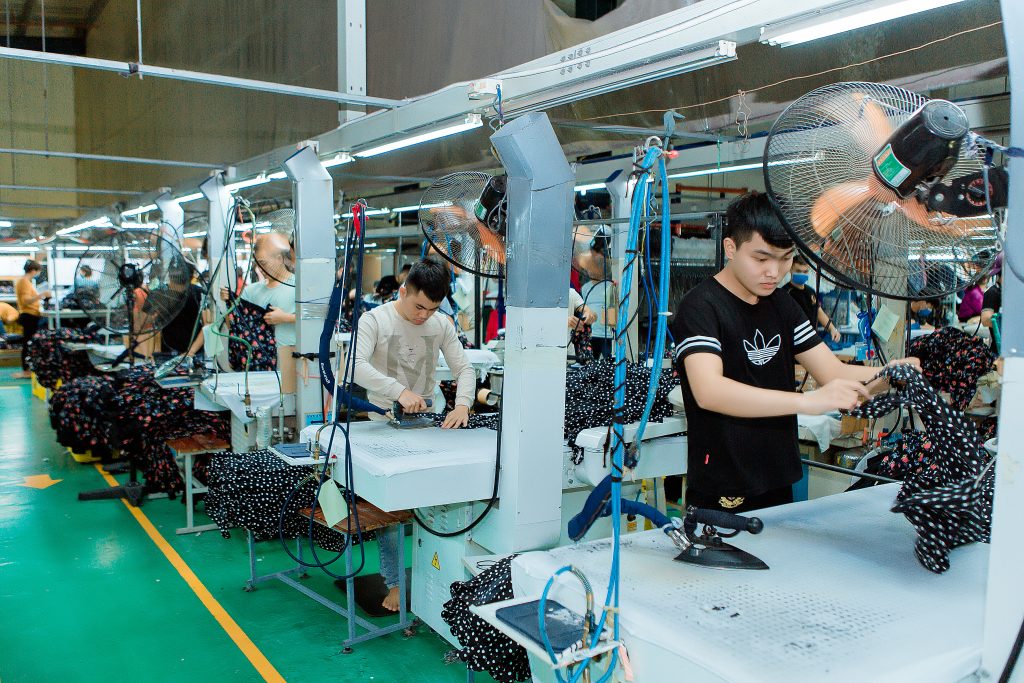
Different types of sewing lines in the garment industry
In the garment industry, the layout of machines and workstations plays a critical role in optimizing workflow. A well-planned sewing line ensures a smooth material flow, minimizes handling time, and enhances production efficiency. Proper sewing line design allows operators to work efficiently with fewer interruptions, improving productivity, quality, and consistency across the garment manufacturing process.
What is a sewing line?
A sewing line refers to the structured arrangement of sewing machines, workstations, tools, and materials in a production area. The purpose of this setup is to create a seamless flow of materials through each operation with minimal backtracking or waiting.
By arranging workstations strategically, factories can streamline the production sequence, balance operator workloads, and increase output. An efficient sewing line reduces lead time, minimizes fabric waste, and strengthens coordination across departments.
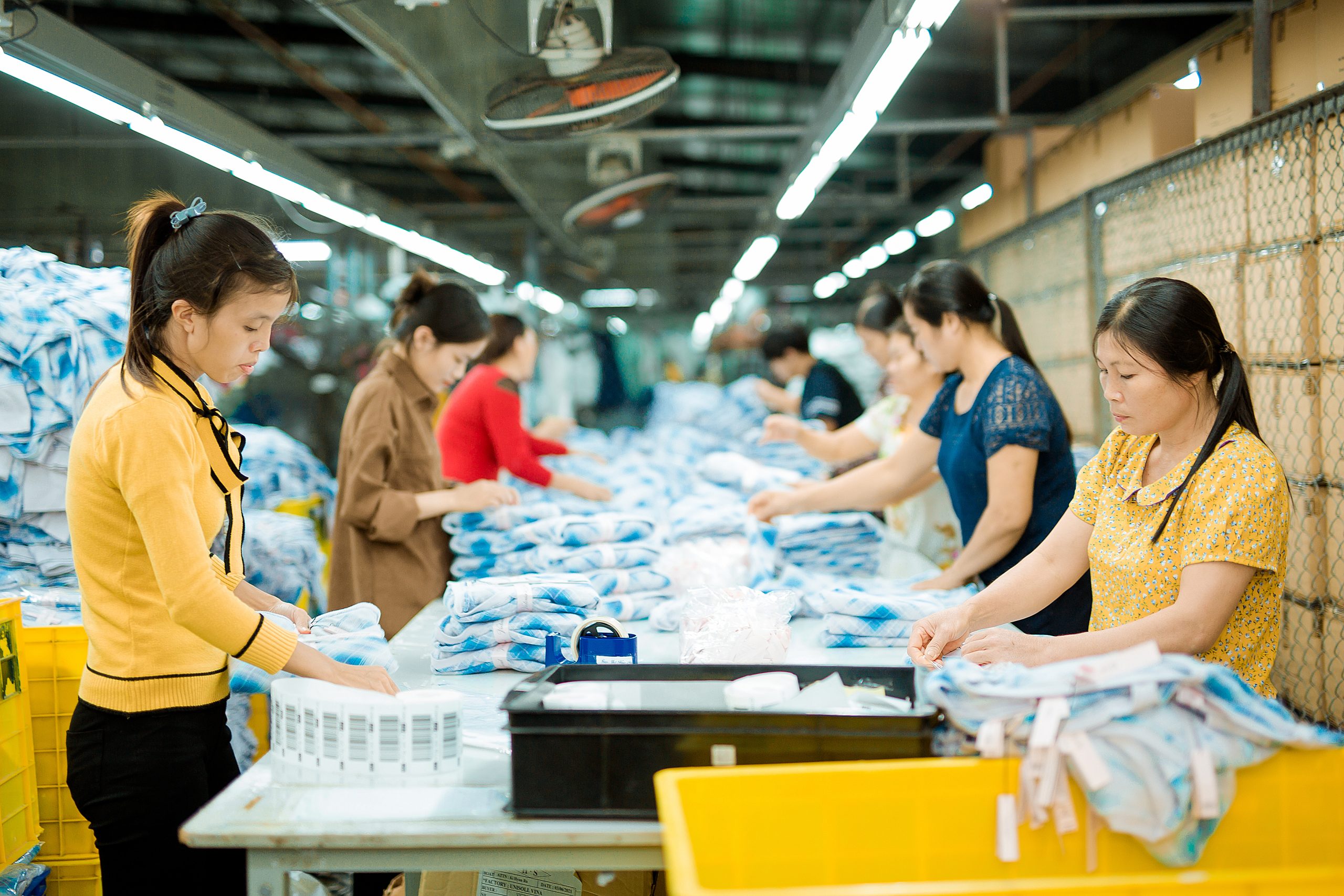
Types of sewing line layouts
Straight line layout
The straight line layout is the most common configuration in the garment industry. Workstations are aligned in a single line, allowing garments to move easily from one station to the next. This system reduces unnecessary handling and waiting time. It is best suited for stable, high-volume styles where production flow remains consistent throughout the shift.
U-shaped layout
The U-shaped layout promotes tighter communication and collaboration among workers. Machines and workstations form a U configuration, reducing walking distance and enabling faster feedback between operators.
This layout improves team coordination and flexibility, especially when handling small or medium-sized production runs.
S-shaped layout
The S-shaped layout features a curved path resembling the letter “S.” It eliminates unnecessary backtracking and ensures smoother transitions between stations. This layout helps distribute work evenly while maintaining continuous material flow, making it suitable for long production sequences or factory floors with structural limitations.
L-shaped layout
In an L-shaped layout, machines are arranged in two perpendicular rows forming an L shape. This design facilitates continuous material movement and reduces bottlenecks.
It also optimizes floor space and allows for effective communication between adjacent stations. The L-shaped system is practical for production areas with columns or restricted floor layouts.
Cellular layout
The cellular layout divides the production line into small units or cells. Each cell contains specific machines and operators assigned to particular operations. These cells can be arranged in straight, U, or L patterns.
This structure is ideal for complex garments that require several subassemblies. It minimizes transportation time and improves quality through focused teamwork.
Crossover layout
The crossover layout uses multiple intersecting lines where operators can cross paths without interfering with one another. This model is efficient for limited floor areas and high operator density.
It enhances material circulation and maximizes production space utilization, making it suitable for compact factories.
Modular layout
The modular layout supports lean manufacturing principles. Machines are grouped strategically so multiple operators can work from a single workstation.
This arrangement reduces idle time and shortens material travel distances. The system allows easy product switching, improving flexibility for factories producing several styles in short runs.
Sewing line checklist for garment factories
Each sewing line has its own use and suitable for different purposes, products and designs. Check the following list to determine on the best layout for your factories:
|
Sewing lines |
When to use |
| Straight line | For one style with large quantities; fastest for long, steady runs. |
| U-Shaped line | For a few styles; promotes easy communication and quick problem-solving. |
| S-Shaped line | For long production sequences; prevents congestion and blockages. |
| L-Shaped line | For floors with columns or obstacles; fits tight spaces while maintaining flow |
| Cellular line | For complex garments with many components; teams handle sections before joining. |
| Modular line | For frequent style changes and short runs; supports one-piece flow. |
By utilizing a vertically integrated production model, Capital World Group consolidates key garment manufacturing stages – from pattern making and cutting to sewing line layout, finishing, and quality assurance – into a single, cohesive system. This comprehensive system ensures that the overall production flow is tightly controlled and highly adaptable, which in turn allows each sewing line to be independently optimized for maximum speed, accuracy, and cost efficiency.

This vertical management structure supports real-time coordination between departments, reduces production delays, and ensures each seam and stitch meets international standards.. Explore our vertical management model to learn how Capital World Group delivers a fully controlled supply chain that enhances flexibility and minimizes production costs.

Women dress manufacturer | Capital World Group
In a market where speed, quality, and sustainability define success, choosing the right dress manufacturer in Vietnam is a strategic decision for fashion brands. Capital World Group has a history of womenswear labels since 2005 with a vertically integrated supply chain that optimizes cost, efficiency, and control from design to delivery.
Why partner with Capital World Group as your dress manufacturer?
Skilled craftsmanship
With more than 40 years of working with fabrics, Capital World Group’s technical teams possess comprehensive knowledge of diverse fabric types, from structured wovens to fluid knits. This expertise allows each project to deliver efficient, precise tailoring that meets aesthetic and functional goals.

Combining experienced craftsmanship with modern machinery, the company produces consistent products quality that reflect both innovation and traditional garment-making discipline.
Sustainability
Sustainability is the compass guiding every garment produced under Capital World Group’s name. Each operation aligns with recognized global standards, including ISO 9001, Higg FEM, amfori BSCI and SLCP certifications.
The company’s approach integrates environmental stewardship with social responsibility, ensuring long-term value for clients and communities alike.
End-to-end supply chain
Through vertical integration, Capital World Group manages every process – from fabric and trim sourcing to pattern development, sampling, bulk production, quality assurance and export. This structure enables rapid 10-day sample turnaround, 500 samples per week and efficient logistics through Hai Phong Port (HPH) or Hanoi Airport (HAN).
The result: lower costs, shorter lead times and reliable quality control.
Why do dresses work for fashion brands?
Versatile in style
Dresses offer instant elegance without complex mix-and-match styling. They provide a complete, time-saving look, ideal for consumers who want refined simplicity with minimal effort – helping brands meet demand for modern, effortless fashion.

Offer everyday comfort
Well-made dresses offer freedom of movement and comfort across settings, from work to leisure. They create a professional yet relaxed appearance without requiring formal wear, appealing to women seeking both practicality and polish.
Not only dresses, Capital World Group also specializes in women’s skirts manufacturing, giving versatile choices for women to elevate their beauty.
Seasonless appeal
Dresses have been worn by women for centuries, maintaining their timeless relevance across climates and cultures.
They adapt easily through the seasons: boots and coats in winter, sandals and hats in spring, making them suitable for everyday wear, the office, and special occasions alike.
Kiara Garments of Capital World Group – Professional dress manufacturer
As a trusted partner, Capital World Group serves global apparel brands seeking a Vietnam garment manufacturer with full supply-chain control and a proven commitment to responsible, end-to-end production.
Kiara Garments, part of Capital World Group’s vertically integrated network, specializes in women’s clothing manufacturing in Vietnam, including dresses, tops, skirts, pants and jumpsuits.

With a focus on precision, ethical manufacturing, and production efficiency, the facility ensures every collection meets global standards for quality and sustainability. Supported by advanced systems and a rigorous QA process, Kiara Garments provides dependable results for international fashion brands.

Women jumpsuit manufacturer in Vietnam by Capital World Group
A jumpsuit is a one-piece outfit that seamlessly combines the top and bottom in one fluid silhouette. Loved for its comfort, style, and versatility, the women’s jumpsuit has become a wardrobe essential that suits both casual and formal occasions. Through our vertically integrated production system, Capital World Group ensures complete control over every stage from design and sourcing to manufacturing and export, providing reliable solutions for global brands seeking trusted women’s jumpsuit manufacturers in Vietnam.
Jumpsuit manufacturing process at Capital World Group
At Capital World Group, we offer a garment manufacturing process of an end-to-end manufacturing solution tailored for global fashion brands.
Design
Every great jumpsuit begins with a great concept, we bring our customers designs, sketches, and ideas alive based on each of their specific requirements.

We offer a range of fabric samples for clients to select from, working with skilled technicians to develop premium fabrics that meet top industry standards. We stay ahead of market shifts and seasonal trends, ensuring that every collection feels modern, refined, and ready for global markets.
Production
Our women’s set manufacturing process combines precision, craftsmanship and advanced technology to ensure consistent results at scale:
- Cutting & marking: After deciding how much fabrics to use for a jumpsuit, patterns are precisely cut to guarantee accurate fits by using a fit point approval checklist to minimize material waste.
- Sewing: Experienced operators assemble each piece with meticulous attention to detail.
- Embellishment & printing: Optional surface treatments and logo applications are executed with precision.
- Pressing: Every garment is pressed to perfection for structure and lasting finish.
Each jumpsuit is designed to flatter every body shape, highlighting natural curves while maintaining a comfortable and confident fit.
Quality check
Capital World Group’s vertically integrated management model ensures strict quality control at every stage of production. Our team follows detailed QC procedures from fabric testing and measurement checks to final packaging to guarantee uniformity and reliability in every batch. This systematic process reflects Capital World Group’s ongoing commitment to quality, professionalism, and customer satisfaction.

Logistics
Once approved, each product moves through our logistics division, where precision continues to drive performance. We handle packing and shipping, with consolidation available for Hai Phong Port (HPH) or Hanoi Airport (HAN).
Export documentation and Incoterms (FOB, CIF, DDP) are managed seamlessly, ensuring smooth and timely deliveries. Capital World Group’s logistics solutions help brands optimize cost and reduce lead time while maintaining full visibility across the supply chain.
Capital World Group – Your trusted jumpsuit manufacturer in Vietnam
Capital World Group is proud to be a trusted vertically integrated jumpsuit manufacturer serving global brands. Our full OEM services streamline production, reduce cost and accelerate time-to-market, allowing clients to focus on design and branding while we handle every stage of production.
Capital World Group specialises in ladies’ clothing manufacturing, producing competitive, high-quality women’s wear that meets global expectations for consistency and craftsmanship. Our factory Kiara Garments has been expanding production capacity while maintaining the highest standards in ethical manufacturing and customer service.

Blazer manufacturer in Vietnam | Capital World Group
Capital World Group is a leading women’s clothing manufacturer in Vietnam, recognized for precision craftsmanship and trend-driven design. Our women’s blazers are produced by a skilled workforce dedicated to quality and innovation. Each piece blends elegant tailoring with comfort and durability, offering versatility for both professional and lifestyle collections. Capital World Group continually evolves with global fashion trends, ensuring every blazer reflects timeless style and modern appeal.
Premium garment manufacturer in Vietnam
As a premium garment manufacturer, Capital World Group offers an extensive range of fabrics and accessories directly at our factory to meet each client’s unique design vision.
Whether working with natural fibers or innovative blends, our materials ensure the perfect balance of style, comfort, and durability. Every fabric undergoes strict quality evaluation to guarantee superior results across all categories of women’s wear.
Sustainable certifications
Sustainability has become a defining direction in the fashion industry as consumers pay more attention to environmental responsibility. At Capital World Group, sustainability is the compass guiding every garment we produce.
Our processes focus on ethical sourcing, waste reduction, and energy efficiency. We are certified under ISO 9001, Higg FEM, amfori BSCI and SLCP, confirming our dedication to sustainable, transparent, and responsible manufacturing.
Precise OEM/ODM procedures
Each blazer product from Capital World Group is tailored to customer specifications through a precise OEM/ODM process that ensures accuracy and efficiency.
Our in-house sample rooms can deliver prototypes in as little as 10 days, with capacity for ≈500 samples per week, helping clients refine collections quickly. With a standard lead time of around 90 days, we provide high-quality products while reducing production and delivery time.
Learn more about The differences between OEM vs. ODM vs. Private Label for your garment production.
Kiara Garments of Capital World Group – Professional blazer manufacturer
Capital World Group specialises in being a ladies’ clothing manufacturer producing competitive, quality women’s blazer.
As part of Capital World Group, Kiara Garments stands out as a professional women’s top manufacturer in Vietnam, combining skilled craftsmanship, modern equipment and ethical production. Our vertically integrated model gives us complete control over design, sampling, production and export ensuring speed, efficiency, and consistent quality.
